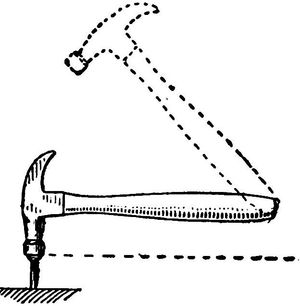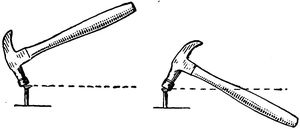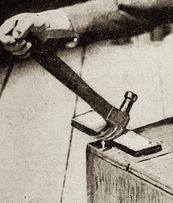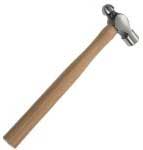
" Helping woodworkers online for the past 20 years"
Hammers 101
A hammer is a tool meant to deliver
an impact to an object. The most common use for hammers in woodworking
is to drive nails.
| Claw Hammer
Claw hammers are the most common types of hammers used for woodworking and general repairs around the home. They are available with different types of handles, wood, steel with rubber or plastic grips and fiberglass composition. There are different weights, 16 ounces is a good general purpose choice, for heavier work perhaps 20 ounces. Smaller weights are suitable for tacks and light work or children. Using a Hammer to Drive Nails
The head of the hammer should be swung back and forth through an arc of a circle of which the wrist is the centre. You must make sure that your wrist is in such a position that the hammer-head can strike the nail squarely—that is, the hammer-handle, when the head rests squarely on the nail-head, must be in a line parallel with the flat surface of the top of the nail (Fig. 603).
If the wrist is much above or below this line, the nail will be struck slantingly, and either be driven crooked or bent (Fig. 604).
When withdrawing nails place a block under the hammer-head as shown to protect the surface of the board. Framing Hammer
Framing hammers, used for framing wooden houses, are heavy duty rip hammers with a straight claw. The hammer heads typically weigh from 20 to 32 ounces for steel heads, and 12 to 16 ounces for titanium heads. Heavy heads, longer handles and milled faces allow for driving large nails quickly into dimensional lumber. The straight claw serves the dual purpose of removing nails and acting as a pry bar to rip apart lumber. Ball Peen
Ball peen hammers are used more in metal working than woodworking however there are times when they are used. The rounded top on the head is used to peen rivets, (the end of the rivet is flattened and rounded so it is tight in the hole). They come in weights ranging from 2 ounces to 3 pounds. Dead Blow Mallet The heads of dead blow mallets are loaded with a loose weight to prevent bounce, and covered with a non marring material, these are used for assembling pieces that have to be tapped into place. Sledge Hammer Made for heavy hitting, driving
stakes, posts etc. these big guys mean business, the one
shown above weighs in at twelve pounds. |
|





